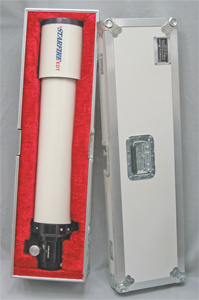Availability
![]() Distribution
Distribution
![]() News
News
![]() Notes
Notes
![]() Overview
Overview
![]() Pricing
Pricing
![]() Products
Products
Accessories and Options
![]() Mounts
Mounts
![]() Mount Control Systems
Mount Control Systems
![]() Telescopes
Telescopes
Astro-Physics 10 Inch (25.4cm) f14.6 Maksutov-Cassegrain High Resolution Telescope
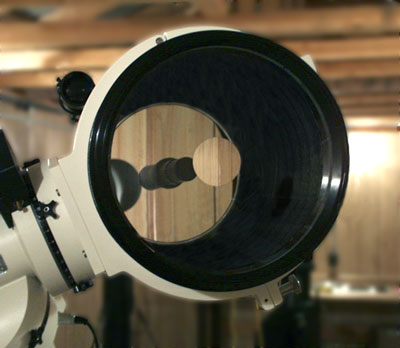
Above: Astro-Physics 10 inch f14.6 telescope installed on optional Model 900 GTO equatorial mount. Note the relatively small central obstruction. (25934 bytes) |
Astro-Physics Co. who are known for making the world's most advanced, versatile, and desired lines of Apochromatic refractor telescopes began the year 2000 with the announcement of their first production Catadioptric telescope!
After more than a decade of research and development to "get it right" Astro-Physics has sold out the first of a limited number of Maksutov "Mak" telescopes. Designated the Astro-Physics 10 inch f14.6 Maksutov Apochromat telescope, this is a compact 33 lb. (15 kg) high resolution instrument designed to provide refractor like views (and images) of the brighter, small objects including the planets, moon, double stars, and the like. Astro-Physics has been working to make a telescope that would be more compact, perform well in temperature extremes around the world, and meet their exacting requirements for optical and mechanical excellence: they have continued their tradition of innovative excellence.
A further goal in this development effort was to equal or to approach the performance of their highly prized triplet apochromatic refractors in at least certain applications. One thought in producing these Catadioptric telescopes is that if a number of customers who do not require the versatility of the Apo refractors (which perform superbly well at extremely high magnifications, and down to very low magnifications) will order the Mak telescopes instead of the triplet Apos then this may take some of the burden from the Triplet production line, and thereby help Astro-Physics to satisfy a far greater number of the more demanding amateur and professional clientele.
Deliveries from the first production run will commence in limited numbers in April of year 2000. It is likely that production will accelerate, and the 10 inch model is likely to be followed by other variants of the design in terms of designed function and aperture.
OPTICAL CHARACTERISTICS
-
The heart of this Maksutov telescope is a special variation of the Gregory design using an elliptical primary and a spherical low-power corrector to achieve the lowest possible central obstruction, yet still maintain a reasonable focal ratio. The optics were designed by Valery Deryuzhin of Aries Instrument Company in the Ukraine. The design is coma-free, and is totally diffraction-limited across the spectrum from the deep infrared through to the ultraviolet - a perfect match for today's premium CCD chips. The small obstruction results in a telescope that shrugs off poor seeing as if it were a refractor, delivering high-contrast performance with super-tight star images.
-
After years of experimenting with 8" and 10" telescope prototypes,
Astro-Physics have found very effective ways to rapidly cool down the optics for stable high-power viewing. They have been testing this 10" design for almost a year now in a variety of environments, from warm summer nights to bitter cold winter conditions with rapidly falling temperatures. With its fused silica primary mirror, the figure is remarkably stable even when the optics are still cooling down to the ambient temperature. To minimize thermal gradients and help the mirror shed its heat,
Astro-Physics designed a special open mirror cell assembly. Cool night air can flow across the back of the mirror. To further speed up the cooling process in the most extreme conditions, the telescope is provided with two small fans which can be operated at full speed, or at a slow whisper quiet speed. The air blows directly at the back of the mirror - no air goes inside the tube and cannot cause particulate contamination of the mirror surfaces.
The primary mirror is a truncated cone designed to eliminate as much thermal mass as possible. The rear surface of the mirror is fine ground and then polished, a process which also helps internal trapped heat to radiate out the open back. By grinding the edge and back of this mirror, any tiny stresses are relieved which could otherwise introduce unwanted distortions in the highly accurate front surface at varying ambient temperatures. In side-by-side tests against closed back scopes with conventional molded mirrors, the Astro-Physics design was faster, by far, in achieving a stable and accurate image.
-
Much has been written pro and con about the need for a small central obstruction. While the light loss of a secondary obstruction is in fact quite small even in telescope with a large obstruction, there are undesirable diffraction effects which will be in direct proportion to the obstruction size.
Astro-Physics observations while using many types of optical systems for more than 20 years have convinced them of the desirability of relatively small obstructions for visual systems. Typically the commercial "production" catadioptric telescopes have overall obstructions of between 35% to 40% (and this includes some
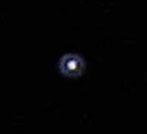
Above: High power image of Vega taken with 10" Mak using an Olympus DL600 digital camera. Seeing was 7 out of 10. Shown is Airy disc and first diffraction ring. (980 bytes) |
Any optical imperfections such as a degree of surface roughness and zonal errors on the optical surface will compound the problem. Astro-Physics tested a commercial telescope where the central obstruction, optical errors and surface roughness were large enough to cause the first diffraction ring and central Airy disc to have almost equal brightness (with a 35% obstruction, theoretically there should be at least a 4 to 1 difference). Even so, this sample telescope "tested" very well on the star test - it had quite similar inside and outside Fresnel patterns and might be judged to be textbook perfect by the star test. Yet it was a very poor performer on all but the most steady of nights, when the seeing was essentially perfect. The slightest motion in the atmosphere would result in a display of "cotton ball" stars. This is one reason why Astro-Physics and Company Seven have not been a major fans of the "star test" to evaluate the actual performance of a telescope. The only unbiased way to measure an optic is with interferometry, or by an MTF (modulation transfer function) test, or with a PSF (point spread function) test, which measures the relative strength of the Airy disc versus the diffraction rings with the image in focus.
-
The Astro-Physics 10" Mak-Cass optics are fabricated by skilled opticians from the Ukrainian Astrophysical Observatory. The optics are hand figured to 1/10 wave (Peak to Valley) using a green light interferometer in a double-pass mode.
Astro-Physics supplies the precision-annealed blanks of Corning fused silica for the mirrors, and the solid blanks of high-quality Ohara BK 7 (Borosilicate crown) for the correctors. By this arrangement there will be no question of internal homogeneity, striae or strain. The components are expensive, but they free the optician to concentrate on making very accurate and smooth curves on the optical surfaces without having to compensate for local discontinuities in the glass, or worrying about the mirror warping during polishing. Fused silica was chosen both for its high stability during polishing and figuring, and for its thermal performance under actual night-sky conditions. The end result is an optical system that does what it is supposed to do - produce unparalleled views of the planets and deep-sky objects.
MECHANICAL CHARACTERISTICS
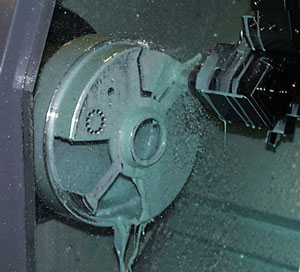
|
-
The 10" Mak optical tube assemblies were designed right from the start with trouble-free precision being the dominant goal. This means the optical collimation is set at the factory and does not change for the life of the instrument. To achieve this, all optics are accurately centered, including the mirror backs. The secondary mirror is actually an aluminized spot on the back surface (r2) of corrector lens, and so this component is maintained in perfect collimation forever. All mounting components are made from solid billets - no fragile die castings are used anywhere! The critical mirror cell starts out as a solid 12 inch (304.8 mm) diameter aluminum slug weighing in excess of 30 lb. (13.6 kg). It is then precisely machined to very tight tolerances on
Astro-Physics in house Mori-Seiki Model SL300 computer controlled turning center. The finished mirror cell with its ventilation cutouts weighs a mere 2 lb. (0.9 kg). The other 28 lb. (12.7 kg) in the form of chips is, of course, recycled. Similar care is taken with the corrector cell and other mounting components. The result is a telescope which you can count on to produce consistently excellent images any time, any place.
Astro-Physics has endeavored to achieve the highest absorption of stray light possible by employing state of the art baffling and anti-reflection techniques; this will help to provide the user with maximum contrast. The exterior of the telescope is finished in a durable textured off white finish, with black anodized focuser and cells; these will retain their beauty for many years. You will appreciate the unique design and fine craftsmanship of this telescope.
-
Astro-Physics chose to employ a moving mirror focuser design in order to best accommodate a wide variety of photographic and visual accessories. The goal was to achieve precise movement of the mirror down to the micron level with absolutely no image shift. To accomplish this,
Astro-Physics designed a pre-loaded axial ball bearing assembly with a precision screw thread, which moves the mirror on its centerline, not off-axis as is done in the majority of commercial
catadioptrics. With this system, your image will stay on that tiny CCD chip regardless of focuser position. You will not need to install any aftermarket Crayford focuser for your critical applications. There is no need to lock the mirror down with external bolts to keep it from shifting during a time exposure. Best of all, the mirror maintains its precise collimation and will not shift or flop around as you slew the telescope from one part of the sky across to the other.
Knife edge baffles are machined into the walls of the telescope optical tube and of the focuser draw tube, these and painted flat black in order to maximize contrast by essentially eliminating any internal reflections. The inside diameter (I.D.) of the draw tube permits the avid astrophotographer to employ up to a 35mm format film or CCD camera to capture images. You can use standard 2 inch diameter accessories, and with the furnished 1.25 inch adapter (threaded for 48mm filters) use common oculars and accessories too. Recessed brass locking rings are installed at each thumbscrew location; as you tighten a thumbscrew a brass locking ring clamps onto the part that has been inserted; consequently the focuser draw tube and any accessories are held securely in place and will not mar the surface of your accessories. This is particularly important considering the heavy and expensive accessories that you may use.
10 Inch f14.6 MAK TELESCOPE:
| SPECIFICATIONS | |
|---|---|
| Color correction: | Less than 0.01% focus variation from 1060nm to 400nm |
| Clear aperture: | 10 Inches (254 mm) |
| Effective focal length: | 146 Inches (3708mm) |
| Focal ratio: | 14.6 Nominal, 13.6 at Min. focus, 15.8 Max. focus |
| Resolution: | 0.45 arc seconds |
| Field size: | 3/4 degree (1.5 moon diameters) over a 2 inch field |
| Mirror Coatings: | Enhanced and Protected Aluminum, 96% transmission in peak visual wavelengths |
| Corrector Lens Coatings: | Broad band multi-coatings on both surfaces (r1 and r2) |
| Central Obstruction: | 2.3 inch, 23% (by diameter) |
| Useful Magnification range: | 67x with 55mm ocular to 927x with 4mm ocular |
| Tube assembly: | White/Black finish, aluminum tube; fully baffled, permanently aligned cell construction; engraved focuser |
| Focuser type: | 2.0 inch Astro-Physics; 2" to 1.25" reducer provided |
| Focus travel: | 9.5 Inches (241mm) |
| Telescope length: | 26 Inches (66cm) without dewcap |
| Telescope diameter | 12 Inches (30.5cm) |
| Optical Tube Weight: | 33 lbs. (15 kg) |
| Carrying case type: | Foam Lined Hard Case |
| Case outside dimensions: | (to be determined) |
| 35mm prime-focus field: | 0.54 x 0.37 x 0.66 degrees |
* Specifications are subject to change without notice.
SAMPLE IMAGES:
-
These are some of the first images taken in December 1999 with the Astro-Physics 10" Mak telescope at the
Astro-Physics observatory, Forest Hills, Illinois. Telescope installed on optional Model 900 mount, using a Starlight Instruments HX516 CCD Camera:
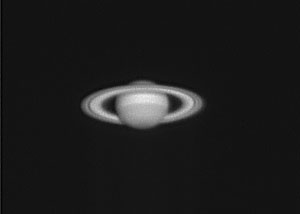
Above: CCD Image of Saturn through Astro-Physics 10 inch f14.6 telescope. Image by Roland Christen. (2998 bytes) |
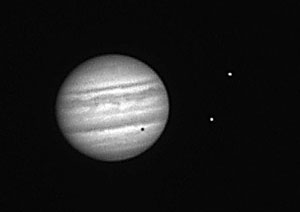
Above: CCD Image of Jupiter through Astro-Physics 10 inch f14.6 telescope. Note the moons with shadow of one moon transiting the planet. Image by Roland Christen. (4642 bytes) |
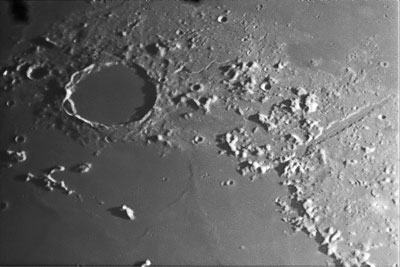
Above: CCD Image of the Moon showing crater "Plato" through Astro-Physics 10 inch f14.6 telescope. Image by Roland Christen. (25030 bytes) |
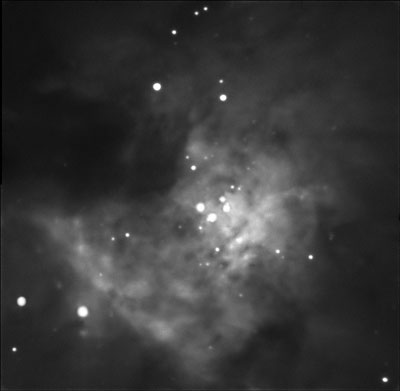
Above: CCD Mosaic Image of Great Nebula in Orion constellation through Astro-Physics 10 inch f14.6 telescope. Image by Roland Christen. (12625 bytes) |
FEATURES OF THE OPTICS
- Very high correction of spherical, and chromatic aberrations.
- Clear, bright, and contrasty images: stunning lunar, planetary, deep-sky views!
- High resolution lens for astronomical or terrestrial imaging.
- Well suited for 35mm format astrophotography; a good match for fine-grained Technical Pan emulsions
- Well suited for CCD imaging (optional focal reducer/telecompressors available)
FEATURES OF THE TUBE ASSEMBLY AND ACCESSORIES
- Compact and very high performance rivaling or outperforming much larger or bulkier telescopes
- Durable, fully machined, corrosion resistant construction
- Fully baffled tube and focuser assures high contrast
- Precise 2 inch focuser facilitates exact photovisual focusing
- 1.25 inch reducing adapter (threaded for 48m filters) with non-marring brass locking ring
- Beautifully machined parts with lustrous finish
- It Works! regardless of ambient temperature
SUGGESTIONS
- Astro-Physics Model 600E German Equatorial Mount with Dual Axis Drive. This very portable mount is perfect for visual studies in either the Northern or Southern Hemispheres.
- Astro-Physics Model 900 German Equatorial Mount with Dual Axis Drive. This transportable mount is perfect for visual studies, and for CCD imaging or film photographic in either the Northern or Southern Hemispheres.
- Baader/Carl Zeiss Binocular Viewer: This accessory accepts two optional matched similar focal length 1.25 inch diameter oculars to permit observing with both eyes simultaneously through a telescope. The resulting images can be breath taking producing a view that is unrivaled in contrast, clarity, with even distribution of light, and appearing three dimensional. Such viewers are particularly desirable for views of the planets, moon, and sun, and on some of the brighter deep sky objects.
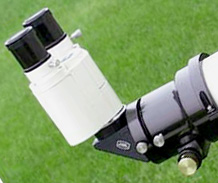
Illustrated Above: Astro-Physics 90mm refractor telescope with optional Binocular Viewer. - Astro-Physics "Maxbright" 2 inch precision Mirror Diagonal. The
"Maxbright" mirror features a very high-tech dielectric coating (developed originally for military optics used in hostile environments such as blowing desert sand) which provide optimum performance and years of use. This diagonal has no aluminum or other reflective metal coating. Instead, the reflective surface consists of 52 layers of thin film oxides similar to those used in anti-reflection coatings. The coatings are deposited by an electron beam evaporator at a high temperature. The result is that reflectivity is above 99% over the entire 4000 to 7000 angstrom photo-visual range. Thin film coatings have extremely low surface scatter compared to aluminum or enhanced aluminum coatings; examination with a laser source shows approximately a five fold improvement in surface scatter.
- Company Seven Airline Transport Association (ATA) Approved Transport Case: Custom engineered and fitted, weather tight case. Protects the telescope from becoming a projectile within the case, and resists abuse and accidental or tampering attempts to invade the case. Suitable for shipping this telescope to any destination around the world.
- TeleVue "Starbeam" Sight/Finder: Beautifully machined and black anodized aluminum, on a quick release machined hardware. Battery powered illuminator is adjustable in brightness. It projects a 10 arc minute diameter red dot onto a transparent 40mm clear aperture window so that the dot appears to be over wherever the scope is pointed. Six arc minute accuracy make "star hopping" easy. Optional mounting hardware is required to employ this, contact us for details as we will support those which telescopes we deliver. Not generally suggested for daytime use.
- 1.25 Inch Prism Diagonal: 45 degree 1.25 inch diameter precision image erecting prism diagonal with high transmission coating. This is a good choice for those who must have an image erect and correct left to right view, and who do not intend to use the telescope at higher magnifications.
- Barlow/Negative Lens: Consider using either our Astro-Physics 2" diameter 2x Barlow, or a TeleVue
"Powermate" lens (available in 2.5X, 4X, or 5X) to increase your magnification and economize your eyepiece selection.
- Eyepieces: This is a telescope that will perform well with very good quality Plossl, and Orthoscopic eyepieces. However, Company Seven recommends the Carl Zeiss Abbe Ortho, and the TeleVue "Nagler Type IV", "Radian", or "Panoptic" eyepieces for the very best performance. Please refer to the photo-visual test report generated by Company Seven as we check through the telescopes (enclosed with those telescopes we deliver) for descriptions of these items and additional suggested accessories.
Your local seeing conditions will greatly affect whether or not you may operate the telescope at its highest magnifications. Please call to discuss this if you have any questions.
Eyepiece Magnification Actual field of view Exit pupil 55mm TeleVue Plossl 67x 0.71 degrees 3.77mm 35mm TeleVue Panoptic 106x 0.60 degrees 2.4mm 34mm Zeiss A. Ortho 109x 0.38 degrees 2.33mm 31mm TeleVue Nagler Type 5 120x 0.64 degrees 2.12mm 27mm Panoptic 137x 0.47 degrees 1.85mm 22mm Nagler Type 4 169x 0.48 degrees 1.51mm 12mm Nagler Type 4 309x 0.26 degrees 0.82mm 6mm Radian 618x 0.10 degrees 0.40mm 4mm Radian 927x 0.06 degrees 0.27mm - Company Seven's ATA Transport/Shipping Case: the case provided by Astro-Physics with each optical tube assembly is a reasonable balance of economy and performance for routine storage of a telescope in a temperature and humidity controlled environment. However, if you plan for long term storage, or if you intend to ship the telescope by commercial carrier or transport it as check in baggage on an airliner (observing oversize and overweight restrictions) then your peace of mind and telescope will both be better served with a custom engineered solution - an ATA case by Company Seven.
Right: Company Seven ATA Case custom fitted for a Astro-Physics 13cm EDT Apochromat Telescope with 2.7 inch Focuser (65,974 bytes).
Click on image to see enlarged view (215,942 bytes).Features include:
- custom fit to accommodate the telescope optical tube with or without accessories (Rings, Focuser, etc.)
- hand fitted velour lining over foams of varying densities to deal with anticipated loads
- weather resistant construction
- combination lock and hasp
- Fedex/UPS label plate
- choice of interior and exterior hard shell material and colors
Left: Astro-Physics Model 900 Mount in optional Company Seven ATA case.
Case 1 of 2 shown here, with Declination housing (left side shown) with GTO Keypad Controller
and Counterweight Shaft (94,326 bytes).
Contents Copyright 1994-2000 Company Seven - All Rights Reserved


